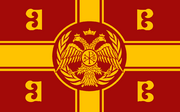Thraysia
This article is incomplete because it is pending further input from participants, or it is a work-in-progress by one author. Please comment on this article's talk page to share your input, comments and questions. Note: To contribute to this article, you may need to seek help from the author(s) of this page. |
{{Infobox country
|native_name = Βασιλεία Ῥωμαίων
|conventional_long_name = Thraysian Empire
|image_flag =  |image_coat =
|image_coat =  |symbol_type = Imperial Ensign
|national_motto = "May the Lord guide us"
|national_anthem = Απολυτίκιο του Τιμίου Σταυρού_(Thraysia)
|symbol_type = Imperial Ensign
|national_motto = "May the Lord guide us"
|national_anthem = Απολυτίκιο του Τιμίου Σταυρού_(Thraysia)![]() |image_map =
|capital = Konstantinopolis
|largest_city = Konstantinopolis
|official_languages = Koine Hellenic
|ethnic_groups =
|image_map =
|capital = Konstantinopolis
|largest_city = Konstantinopolis
|official_languages = Koine Hellenic
|ethnic_groups =
- not!Macedonian
- not!Arabic
- not!Slovakian
- not!Armenian
- not!Turkic
- Other
|demonym = Thraysian |religion = [[Eastern Orthodox| |government_type = Absolute Monarchy |leader_title1 = Emperor |leader_name1 = Alexios VIII Gregoras |leader_title2 = Heir |leader_name2 = Alexios VIV Gregoras |legislature = Imperial Council |established_event1 = Rebellion against the Latins |established_date1 = |established_event2 = Restoration of the Thraysian Empire |established_date2 = |established_event3 = Second Restoration of the Thraysian Empire |established_date3 = |area = |area_km2 = |area_sq_mi = |area_footnote = |percent_water = |area_label = |area_label2 = |area_dabodyalign = |population_estimate_year = 2019 |population_estimate = 94,593,874 |population_census = |population_census_year = |population_density_km2 = |population_density_sq_mi = |population_density_rank = |GDP_PPP = $4,326,186,250,072 |GDP_PPP_rank = |GDP_PPP_year = 2018 |GDP_PPP_per_capita = |GDP_PPP_per_capita_rank = |GDP_nominal = |GDP_nominal_rank = |GDP_nominal_year = 2019 |GDP_nominal_per_capita = $18,657 |GDP_nominal_per_capita_rank = |Gini = |Gini_rank = |Gini_year = |Gini_change = |Gini_category = |HDI = |HDI_rank = |HDI_year =2018 |HDI_change = |HDI_category = |currency =Bezant (☧) |currency_code =BZT |time_zone =Thraysian Imperial Time |utc_offset = +3 |time_zone_DST = |antipodes = |date_format = mm-dd-yyyy |DST_note = |utc_offset_DST = |drives_on = Left |cctld = |iso3166code = |calling_code = +32 |image_map3 = |alt_map3 = |footnotes = |footnote2 = |footnote7 = }} Thraysia, officially the Thraysian Empire, is a sovereign country located in the far east of Belisaria, sharing borders with Iotopha and Uluujol. It has coasts among the Periclean and Ozeros Seas. With over 94 million subjects, it is one of the more populated nations in Ajax.
Thraysia is a semi-federal absolute monarchy. The current Emperor is Alexios VIII, who has reigned since 2001. The Emperor remains the primary figure in politics and is the final authority in all political decisions. In theory, the Emperor is acclaimed to have absolute power, claiming titles such as "sole ruler of the world" and "peer of the apostles." In practice, the Thraysian Charter of Liberties, the concept of "antiemperors," and semi-federal autonomy provide protections against tyranny.
The heartland of the Thraysian Empire traces its roots to Hellenic settlements among its coasts, its indigenous peoples, and not!Macedonian invaders. Some of the region was unified under the ancient Empire until its collapse and fall to Latin rule. The Thraysian Empire officially formed as a client King organized a large-scale rebellion among its eastern provinces. It grew into an Empire that would become the most powerful economic, cultural, and military force in Belisarnia. Later, it would be challenged by the rise of the Holy Audonian Empire and Latin Empire. Barbarian invaders and Caliphate invasions would result in its reduction of size. Eventually, it fell to the Tuluran Caliphate in the late 15th Century.
The Thraysian Empire revived during the reconquest era in the 18th Century. As it seemed to have fallen somewhat behind its western neighbors, Stephanos I (1751-1784) began enacting reforms to forcibly westernize Thraysia in hopes of its modernization. It replaced many of its social and political systems dating to the Middle Ages with ones that were based on western models and the Enlightenment. Westernization efforts applied much more to the upper class than the commoners. As the wealth gap increased under the "pseudo-industrialization" era and caused social unrest, a violent uprising overthrew the Thraysian government with a new one that began the "nationalist revolution." A cultural renaissance flourished and revived aspects of medieval Thraysian culture while forming an "anti-western" identity.
The modern day Empire is a developed market, though it remains somewhat behind the most developed nations of Belisaria. Its economy is driven by industries such as manufacturing, textiles, and mining of gold and other natural resources in its significant deposits down south.
Thraysia is known for being a fervently religious and extremely conservative society, fueled by a long-lived nostalgia for the medieval Thraysian Empire and its success. Its religious life is characterized by the Eastern Orthodox Church, which plays a large influence in politics. Culturally, the Empire is multi-ethnic, with separatist sentiments among its not!Slavic and not!Armenian peoples.